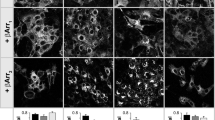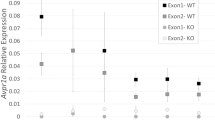Abstract
THE neurohypophyseal hormone arginine vasopressin has diverse actions1–7 , including the inhibition of diuresis, contraction of smooth muscle, stimulation of liver glycogenolysis and modulation of adrenocorticotropic hormone release from the pituitary. Arginine vasopressin receptors are G protein-coupled and have been divided into at least three types8; the Via (vascular/hepatic)1,9–11and Vlb (anterior pituitary)12 receptors which act through phosphatidylinositol hydrolysis to mobilize intracellular Ca2+, and the V2 (kidney) receptor1,13,14which is coupled to adenylate cyclase. We report here the cloning of a complementary DNA encoding the hepatic Via arginine vasopressin receptor. The liver cDNA encodes a protein with seven putative transmembrane domains, which binds arginine vasopressin and related compounds with affinities similar to the native rat Via receptor. The messenger RNA corresponding to the cDNA is distributed in rat tissues known to contain Via receptors.
This is a preview of subscription content, access via your institution
Access options
Subscribe to this journal
Receive 51 print issues and online access
$199.00 per year
only $3.90 per issue
Buy this article
- Purchase on Springer Link
- Instant access to full article PDF
Prices may be subject to local taxes which are calculated during checkout
Similar content being viewed by others
References
Jard, S. Front. Hormont Res. 13, 89–104 (1985).
van Ree, J. M., Bonus, B., Versteeg, D. H. G. & de Wied, D. Biochem. Pharmac. 27, 1793–1800 (1978).
Gillies, G., Linton, E. A. & Lowry, P. J. Nature 299, 355–357 (1982).
de Wied, D. Life Sci. 20, 192–294 (1977).
Kasting, N. W., Veal, W. C. & Couper, K. E. Can. J. Physiol. Pharmac. 58, 316–319 (1980).
Matsuguchi, H., Schmid, P. G., Gorden, F. J. & Johnson, A. K. Physiologist 23, 29–33 (1980).
Clements, J. A. & Funder, J. W. Endocr. Rev. 116, 416–423 (1986).
Michell, R. H., Kirk, C. J. & Billah, M. M. Biochem. Soc. Trans. 7, 861–865 (1979).
Kirk, C. J., Verrinder, T. R. & Hems, D. A. FEBS Lett. 83, 267–271 (1977).
Aiyar, N., Nambi, P., Stassen, F. L. & Crooke, S. J. Life Sci. 39, 37–45 (1986).
Nambi, P., Whitman, M., Gessner, G., Aiyar, N. & Crooke, S. J. Proc. natn. Acad. Sci. U.S.A. 83, 8492–8495 (1986).
Antoni, F. A. Neuroendocrinology 39, 186–188 (1984).
Chase, L. R. & Aurbach, G. D. Science 159, 545–547 (1968).
Butlen, D. et al. Molec. Pharmac. 14, 1006–1017 (1978).
Kozak, M. Nucleic Acids Res. 12, 857–872 (1984).
Bunzow, J. R. et al. Nature 336, 783–787 (1988).
Kozak, M. Nucleic Acids Res. 12, 857–872 (1984).
Bunzow, J. R. et al. Nature 336, 783–787 (1988).
Kobilka, B. K. et al. Nature 329, 75–79 (1987).
Yokota, Y. et al. J. biol. Chem. 264, 17649–17652 (1989).
Arai, H., Hori, S., Aramori, I., Ohkubo, H. & Nakanishi, S. Nature 348, 730–732 (1990).
Hirata, M. et al. Nature 349, 617–620 (1991).
Matsuda, L. A., Lolait, S. J., Brownstein, M. J., Young, A. C. & Bonner, T. I. Nature 346, 561–564 (1990).
Phillips, P. et al. Endocrinology 126, 1478–1484 (1990).
Meidan, R. & Hsueh, A. J. W. Endocrinology 116, 416–423 (1985).
Thibonnier, M., Snajdar, R. M. & Rapp, J. P. Am. J. Physiol. 251, 115–120 (1986).
Woods, N. M., Cuthbertson, K. S. R. & Cobbold, P. H. Nature 319, 600–602 (1986).
Chen, C. & Okayama, H. Molec. cell. Biol. 7, 2745–2752 (1987).
Holmes, M. C., Antoni, F. A. & Szentendrei, T. Neuroendocrinology 39, 162–169 (1984).
Antoni, F. A. Neuropeptides 4, 413–420 (1984).
Balla, T., Enyedi, P., Spat, A. & Antoni, F. Endocrinology 117, 421–423 (1985).
Okayama, H. et al. Meth. Enzym. 154, 3–28 (1987).
Kimura, T., Tanizawa, O., Mori, K., Brownstein, M. J. & Okayama, H. Nature 356, 526–529 (1992).
Author information
Authors and Affiliations
Rights and permissions
About this article
Cite this article
Morel, A., O'Carroll, AM., Brownstein, M. et al. Molecular cloning and expression of a rat Via arginine vasopressin receptor. Nature 356, 523–526 (1992). https://doi.org/10.1038/356523a0
Received:
Accepted:
Issue Date:
DOI: https://doi.org/10.1038/356523a0
This article is cited by
-
Air sac and gill vasotocin receptor gene expression in the air-breathing catfish Heteropneustes fossilis exposed to water and air deprivation conditions
Fish Physiology and Biochemistry (2022)
-
β-Arrestin 2 mediates arginine vasopressin-induced IL-6 induction via the ERK1/2-NF-κB signal pathway in murine hearts
Acta Pharmacologica Sinica (2020)
-
Vasopressin in circadian function of SCN
Journal of Biosciences (2020)
-
Vasopressin regulates the growth of the biliary epithelium in polycystic liver disease
Laboratory Investigation (2016)
-
Vasopressin and hydration play a major role in the development of glucose intolerance and hepatic steatosis in obese rats
Diabetologia (2015)
Comments
By submitting a comment you agree to abide by our Terms and Community Guidelines. If you find something abusive or that does not comply with our terms or guidelines please flag it as inappropriate.



